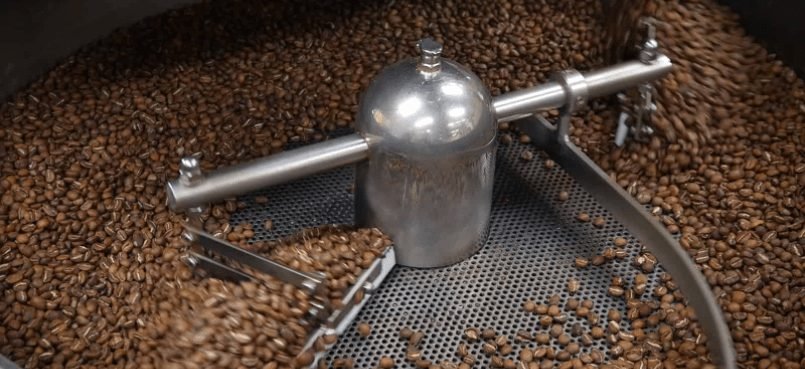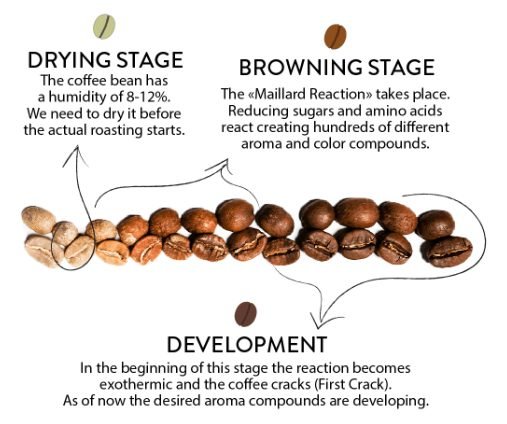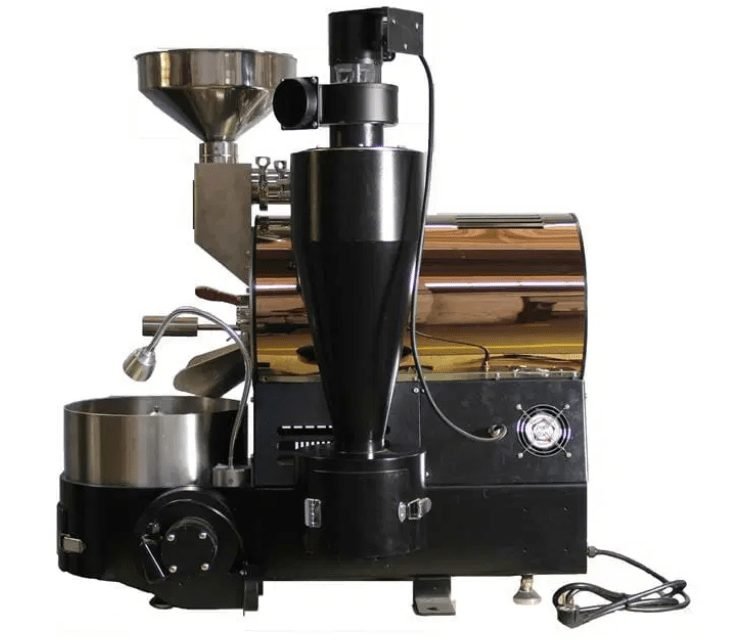The Basics of Roasting Coffee: Developing Flavor
- Home
- Blog
- Coffee Marketing Ideas and Advice
The Basics of Roasting Coffee: Developing Flavor
Estimated Reading Time: 15 minutes
I’m sure every barista wishes they knew more about roasting! We can add flavor to coffee by roasting it.
How can we make the best-tasting coffee possible? What exactly happens during the roasting process?

Why is Roasting Important?
Coffee beans are matured seeds from the coffee cherry. After that, they are processed and dried into coffee beans. Coffee beans are green before roasting and have a beany and grassy scent.
Green coffee beans, in fact, do not smell like coffee at all. Once can produce 800 to 1000 different fragrance molecules when the coffee is roasted. These chemicals contribute to the flavor of coffee.
Roast profiling allows you to influence the presence of these scent components in coffee while also determining the flavor of the coffee.

The Process of Roasting Coffee
The roasting process transforms green coffee beans into brown ones. It can be made in a variety of methods, which influences the flavor.

In this section, I will go through the fundamentals of roasting as well as commercial roasting.
Stages of Roasting
Roasting is divided into three stages: drying, browning, and development (or roasting).
1. Drying Stage
The moisture of a coffee bean ranges between 8 and 12%. We need to dry it before we start roasting. With a classic drum roaster, the drying stage usually lasts 4–8 minutes.
The temperature at the end of the drying step is approximately 160 0C. You must be careful, especially with drum roasters, not to burn the beans by applying too much heat at the start.
Because the final act of roasting is exothermic, the drying stage is also vital for gathering energy for the bean (heat producing).
2. Browning Stage
The coffee begins to smell like toasted bread and hay at 160 0C. This is the stage at which scent precursors begin to transform into fragrance compounds. Despite the fact that the browning step comes after the drying cycle, drying continues during the browning stage.
The Maillard process, which is responsible for browning, begins during the browning stage. Reducing sugars and amino acids react in the Maillard process, producing hundreds of distinct fragrance and color chemicals called as melanoids.
Some roast masters, on the other hand, want the roast to slow down during this period so that the flavors can develop. The coffee begins to pop at the end of the browning step. This is referred to as the first crack, and the development stage begins.
3. Development or Roasting Stage
The reaction becomes exothermic at the start of the growth stage, and the coffee cracks. The bean has accumulated energy during the drying and browning steps, which causes the coffee to erupt.
When the desired scent compounds are developing, this is referred to as development period. During the development stage, slowing down the roast could result in coffee that tastes smoky and has an overpowering flavor.
Depending on the intended flavor profile and roast degree, the length of the development stage is typically 15–25% of the entire roast time.

Roast Degree
One of the most crucial signs with the roast is the roast degree. It can be determined with a color meter or by tasting. Roasters typically strive to enhance coffee’s natural flavors while also determining the roast degree.
Light roasted coffees are typically more acidic, whereas dark roasted coffees are more bitter. Also, light roasts have a fruitier flavor as compared to dark roasts, which have a more roasty and burnt taste.
When roasted for a longer period of time, this molecule degrades into less fruity chemicals. As the number of sulfuric compounds increases, the flavor becomes roasty and burned.
As a rule of thumb, light roasted coffee brings out the flavor of the raw coffee better. Lightly roasted coffee is easy to distinguish from darkly roasted coffee.
Roast Time
In addition to roast degree, roast duration and roasting time are equally important metrics for determining coffee flavor. If you roast quickly, you’ll receive more of the desired fragrance components. However, take cautious not to burn the beans!
The overall flavor of coffee (fruity, berry-like, chocolaty, and nutty) is stronger. Fast roasting also increases the number of fragrance components produced at the beginning of the growth stage.

Roaster Designs
There are various roaster designs. The design influences the thermodynamics of roasting, and different equipment can produce different flavors of coffee.
In small roasters, beans rotate in drums heated underneath by either an indirect or a direct flame. This increases the energy volume of roasters. Roasting using these machines is fairly steady, however the roast masters should be able to plan ahead of time for up to minutes.
If you wish to roast the beans gradually, you should use a drum roaster since high temperatures can burn the beans at the beginning of the process.
Fluidized bed roasters have long been used in the industry. The roaster is heated indirectly by hot air in a fluidized bed roaster. As a result, the roasting can be controlled more quickly.
It is possible to roast faster without burning the bean from the exterior with fluidized bed roasters, as well as to increase the scent of the coffee. Other hybrid roasters are available, including Loring Roasters, which have a drum and heat indirectly by hot air.
Every coffee roaster is unique, so answering this question relies on how you have already established your brand. If you have a fun, trendy roastery, you’ll feel right at home at merch, but if you have a classic brand that’s untouched by corporate culture, you may have trouble connecting with customers.

Are You Roasting for Filter Coffee or Espresso?
Did you ever wonder how filter coffee differs from espresso coffee?
Gravity is used to extract filters, and the process is relatively gentle. For the filter, you might choose a more aromatic and acidic coffee.
In contrast, espresso is extracted at a pressure of 9 bar. This means that more flavor is extracted into the cup. Coffee roasted for espresso may not be as delicious when made as filter coffee, and vice versa.
It is common for roast masters often roast just to maximize the bean and not for the extraction process, which means they should aim for a midpoint between too light and too dark to ensure that the coffee will work for both.
Espresso is traditionally a dark-roasted coffee with a low acidity and a large body. There are different roasting methods for filter coffee in different countries, however, the roasting degree is typically lighter than for espresso, and roast styles have become more flexible than in the past.
Overall, learning to roast is an adventure that never ends. It’s never too late to learn more about the bean. The most exciting aspect of the job is determining the appropriate roast profile for the attributes of the coffee.
I hope you liked reading and found it useful in your coffee adventure!